Project Life Cycle Management and Technology in UAE Construction
VerifiedAdded on 2023/01/07
|23
|8859
|93
Report
AI Summary
This report delves into the application of technology within the project life cycle management framework of the UAE construction industry. It begins by establishing the background, aim, objectives, and significance of the study, alongside the research questions and the structure of the dissertation. A comprehensive literature review explores project life cycle management, the use of various technologies like Virtual Prototyping, AI, VR, and BIM, benefits, and challenges associated with technology adoption. The methodology chapter outlines the research type, approach, philosophy, design, data collection, sampling, analysis, and ethical considerations. The report aims to examine the use of technology in project life cycle management in the construction industry within the UAE, analyzing different technologies, identifying benefits and challenges, and recommending ways to overcome these challenges. The findings, discussion, and conclusion chapters are expected to present results, support findings with literature, and offer recommendations for future technology integration in the industry.

Paraphrase This Document
Need a fresh take? Get an instant paraphrase of this document with our AI Paraphraser
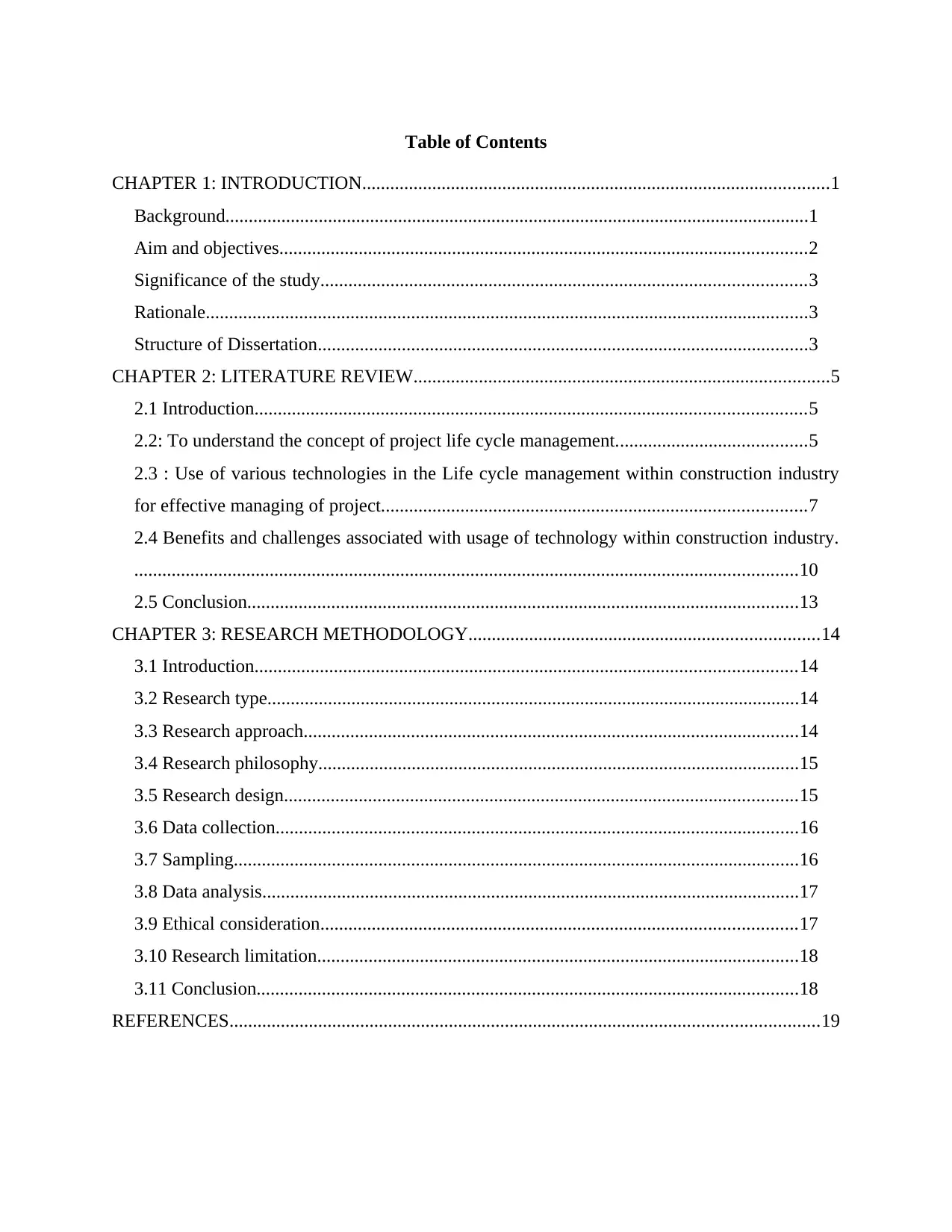
Table of Contents
CHAPTER 1: INTRODUCTION....................................................................................................1
Background.............................................................................................................................1
Aim and objectives.................................................................................................................2
Significance of the study........................................................................................................3
Rationale.................................................................................................................................3
Structure of Dissertation.........................................................................................................3
CHAPTER 2: LITERATURE REVIEW.........................................................................................5
2.1 Introduction......................................................................................................................5
2.2: To understand the concept of project life cycle management.........................................5
2.3 : Use of various technologies in the Life cycle management within construction industry
for effective managing of project...........................................................................................7
2.4 Benefits and challenges associated with usage of technology within construction industry.
..............................................................................................................................................10
2.5 Conclusion......................................................................................................................13
CHAPTER 3: RESEARCH METHODOLOGY...........................................................................14
3.1 Introduction....................................................................................................................14
3.2 Research type..................................................................................................................14
3.3 Research approach..........................................................................................................14
3.4 Research philosophy.......................................................................................................15
3.5 Research design..............................................................................................................15
3.6 Data collection................................................................................................................16
3.7 Sampling.........................................................................................................................16
3.8 Data analysis...................................................................................................................17
3.9 Ethical consideration......................................................................................................17
3.10 Research limitation.......................................................................................................18
3.11 Conclusion....................................................................................................................18
REFERENCES..............................................................................................................................19
CHAPTER 1: INTRODUCTION....................................................................................................1
Background.............................................................................................................................1
Aim and objectives.................................................................................................................2
Significance of the study........................................................................................................3
Rationale.................................................................................................................................3
Structure of Dissertation.........................................................................................................3
CHAPTER 2: LITERATURE REVIEW.........................................................................................5
2.1 Introduction......................................................................................................................5
2.2: To understand the concept of project life cycle management.........................................5
2.3 : Use of various technologies in the Life cycle management within construction industry
for effective managing of project...........................................................................................7
2.4 Benefits and challenges associated with usage of technology within construction industry.
..............................................................................................................................................10
2.5 Conclusion......................................................................................................................13
CHAPTER 3: RESEARCH METHODOLOGY...........................................................................14
3.1 Introduction....................................................................................................................14
3.2 Research type..................................................................................................................14
3.3 Research approach..........................................................................................................14
3.4 Research philosophy.......................................................................................................15
3.5 Research design..............................................................................................................15
3.6 Data collection................................................................................................................16
3.7 Sampling.........................................................................................................................16
3.8 Data analysis...................................................................................................................17
3.9 Ethical consideration......................................................................................................17
3.10 Research limitation.......................................................................................................18
3.11 Conclusion....................................................................................................................18
REFERENCES..............................................................................................................................19
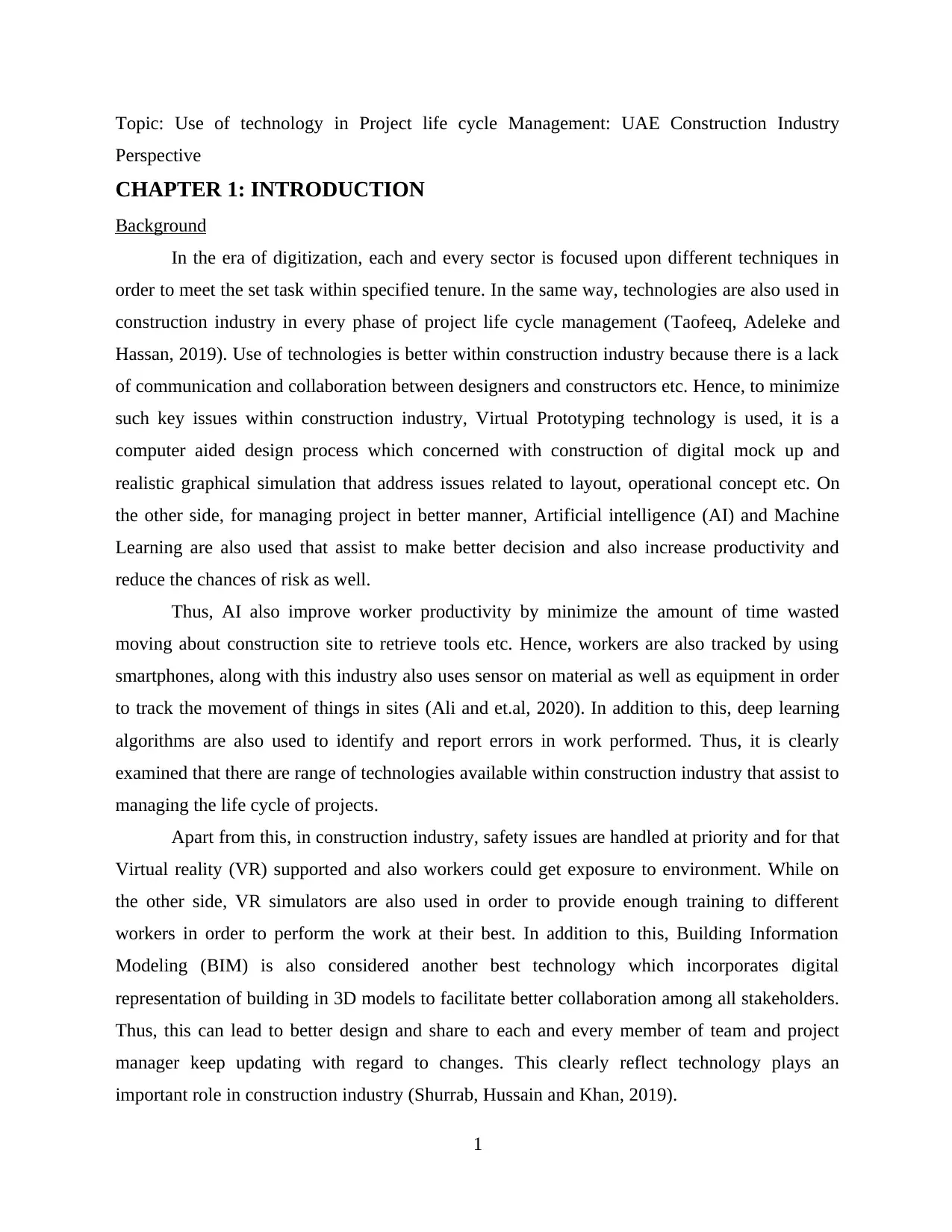
Topic: Use of technology in Project life cycle Management: UAE Construction Industry
Perspective
CHAPTER 1: INTRODUCTION
Background
In the era of digitization, each and every sector is focused upon different techniques in
order to meet the set task within specified tenure. In the same way, technologies are also used in
construction industry in every phase of project life cycle management (Taofeeq, Adeleke and
Hassan, 2019). Use of technologies is better within construction industry because there is a lack
of communication and collaboration between designers and constructors etc. Hence, to minimize
such key issues within construction industry, Virtual Prototyping technology is used, it is a
computer aided design process which concerned with construction of digital mock up and
realistic graphical simulation that address issues related to layout, operational concept etc. On
the other side, for managing project in better manner, Artificial intelligence (AI) and Machine
Learning are also used that assist to make better decision and also increase productivity and
reduce the chances of risk as well.
Thus, AI also improve worker productivity by minimize the amount of time wasted
moving about construction site to retrieve tools etc. Hence, workers are also tracked by using
smartphones, along with this industry also uses sensor on material as well as equipment in order
to track the movement of things in sites (Ali and et.al, 2020). In addition to this, deep learning
algorithms are also used to identify and report errors in work performed. Thus, it is clearly
examined that there are range of technologies available within construction industry that assist to
managing the life cycle of projects.
Apart from this, in construction industry, safety issues are handled at priority and for that
Virtual reality (VR) supported and also workers could get exposure to environment. While on
the other side, VR simulators are also used in order to provide enough training to different
workers in order to perform the work at their best. In addition to this, Building Information
Modeling (BIM) is also considered another best technology which incorporates digital
representation of building in 3D models to facilitate better collaboration among all stakeholders.
Thus, this can lead to better design and share to each and every member of team and project
manager keep updating with regard to changes. This clearly reflect technology plays an
important role in construction industry (Shurrab, Hussain and Khan, 2019).
1
Perspective
CHAPTER 1: INTRODUCTION
Background
In the era of digitization, each and every sector is focused upon different techniques in
order to meet the set task within specified tenure. In the same way, technologies are also used in
construction industry in every phase of project life cycle management (Taofeeq, Adeleke and
Hassan, 2019). Use of technologies is better within construction industry because there is a lack
of communication and collaboration between designers and constructors etc. Hence, to minimize
such key issues within construction industry, Virtual Prototyping technology is used, it is a
computer aided design process which concerned with construction of digital mock up and
realistic graphical simulation that address issues related to layout, operational concept etc. On
the other side, for managing project in better manner, Artificial intelligence (AI) and Machine
Learning are also used that assist to make better decision and also increase productivity and
reduce the chances of risk as well.
Thus, AI also improve worker productivity by minimize the amount of time wasted
moving about construction site to retrieve tools etc. Hence, workers are also tracked by using
smartphones, along with this industry also uses sensor on material as well as equipment in order
to track the movement of things in sites (Ali and et.al, 2020). In addition to this, deep learning
algorithms are also used to identify and report errors in work performed. Thus, it is clearly
examined that there are range of technologies available within construction industry that assist to
managing the life cycle of projects.
Apart from this, in construction industry, safety issues are handled at priority and for that
Virtual reality (VR) supported and also workers could get exposure to environment. While on
the other side, VR simulators are also used in order to provide enough training to different
workers in order to perform the work at their best. In addition to this, Building Information
Modeling (BIM) is also considered another best technology which incorporates digital
representation of building in 3D models to facilitate better collaboration among all stakeholders.
Thus, this can lead to better design and share to each and every member of team and project
manager keep updating with regard to changes. This clearly reflect technology plays an
important role in construction industry (Shurrab, Hussain and Khan, 2019).
1
⊘ This is a preview!⊘
Do you want full access?
Subscribe today to unlock all pages.

Trusted by 1+ million students worldwide
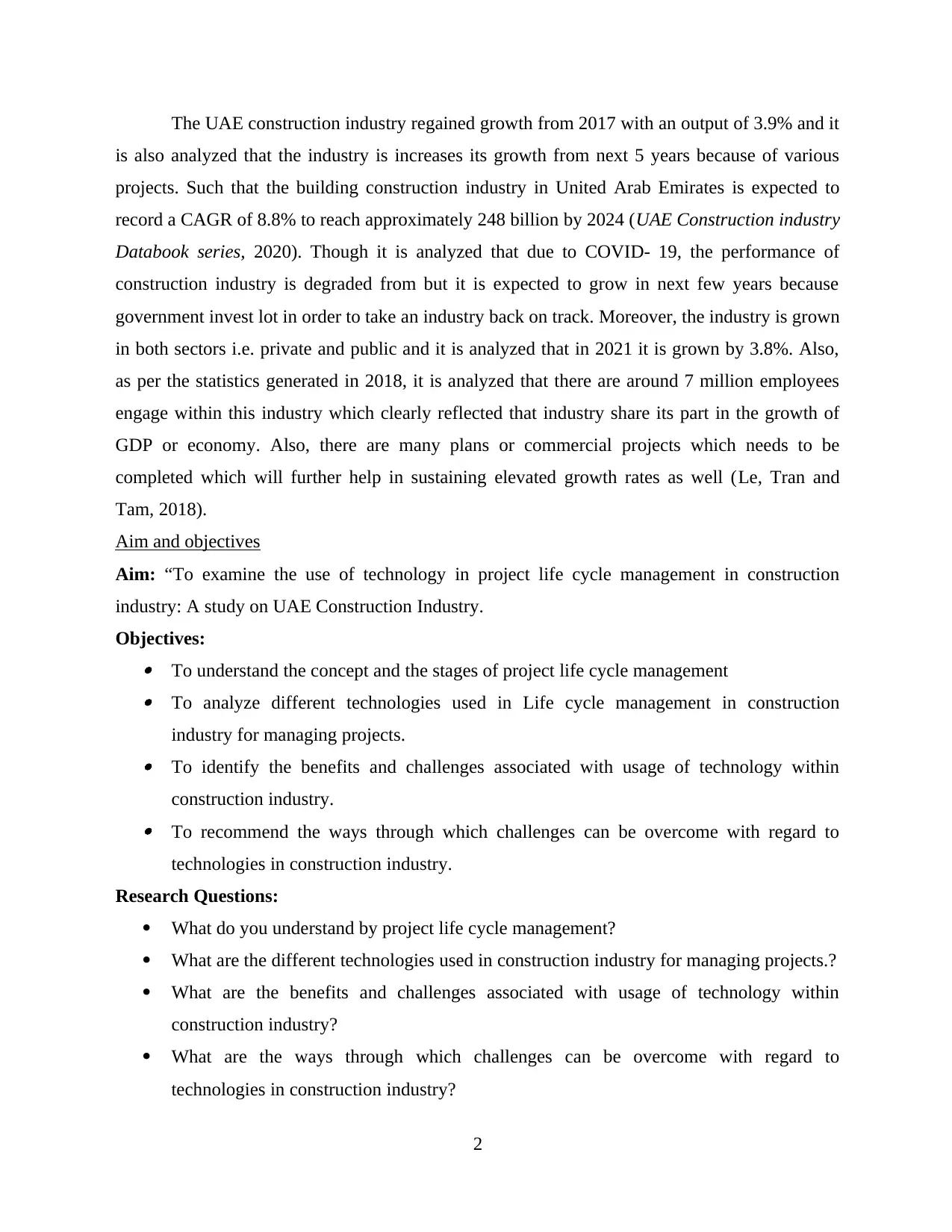
The UAE construction industry regained growth from 2017 with an output of 3.9% and it
is also analyzed that the industry is increases its growth from next 5 years because of various
projects. Such that the building construction industry in United Arab Emirates is expected to
record a CAGR of 8.8% to reach approximately 248 billion by 2024 (UAE Construction industry
Databook series, 2020). Though it is analyzed that due to COVID- 19, the performance of
construction industry is degraded from but it is expected to grow in next few years because
government invest lot in order to take an industry back on track. Moreover, the industry is grown
in both sectors i.e. private and public and it is analyzed that in 2021 it is grown by 3.8%. Also,
as per the statistics generated in 2018, it is analyzed that there are around 7 million employees
engage within this industry which clearly reflected that industry share its part in the growth of
GDP or economy. Also, there are many plans or commercial projects which needs to be
completed which will further help in sustaining elevated growth rates as well (Le, Tran and
Tam, 2018).
Aim and objectives
Aim: “To examine the use of technology in project life cycle management in construction
industry: A study on UAE Construction Industry.
Objectives: To understand the concept and the stages of project life cycle management To analyze different technologies used in Life cycle management in construction
industry for managing projects. To identify the benefits and challenges associated with usage of technology within
construction industry. To recommend the ways through which challenges can be overcome with regard to
technologies in construction industry.
Research Questions:
What do you understand by project life cycle management?
What are the different technologies used in construction industry for managing projects.?
What are the benefits and challenges associated with usage of technology within
construction industry?
What are the ways through which challenges can be overcome with regard to
technologies in construction industry?
2
is also analyzed that the industry is increases its growth from next 5 years because of various
projects. Such that the building construction industry in United Arab Emirates is expected to
record a CAGR of 8.8% to reach approximately 248 billion by 2024 (UAE Construction industry
Databook series, 2020). Though it is analyzed that due to COVID- 19, the performance of
construction industry is degraded from but it is expected to grow in next few years because
government invest lot in order to take an industry back on track. Moreover, the industry is grown
in both sectors i.e. private and public and it is analyzed that in 2021 it is grown by 3.8%. Also,
as per the statistics generated in 2018, it is analyzed that there are around 7 million employees
engage within this industry which clearly reflected that industry share its part in the growth of
GDP or economy. Also, there are many plans or commercial projects which needs to be
completed which will further help in sustaining elevated growth rates as well (Le, Tran and
Tam, 2018).
Aim and objectives
Aim: “To examine the use of technology in project life cycle management in construction
industry: A study on UAE Construction Industry.
Objectives: To understand the concept and the stages of project life cycle management To analyze different technologies used in Life cycle management in construction
industry for managing projects. To identify the benefits and challenges associated with usage of technology within
construction industry. To recommend the ways through which challenges can be overcome with regard to
technologies in construction industry.
Research Questions:
What do you understand by project life cycle management?
What are the different technologies used in construction industry for managing projects.?
What are the benefits and challenges associated with usage of technology within
construction industry?
What are the ways through which challenges can be overcome with regard to
technologies in construction industry?
2
Paraphrase This Document
Need a fresh take? Get an instant paraphrase of this document with our AI Paraphraser
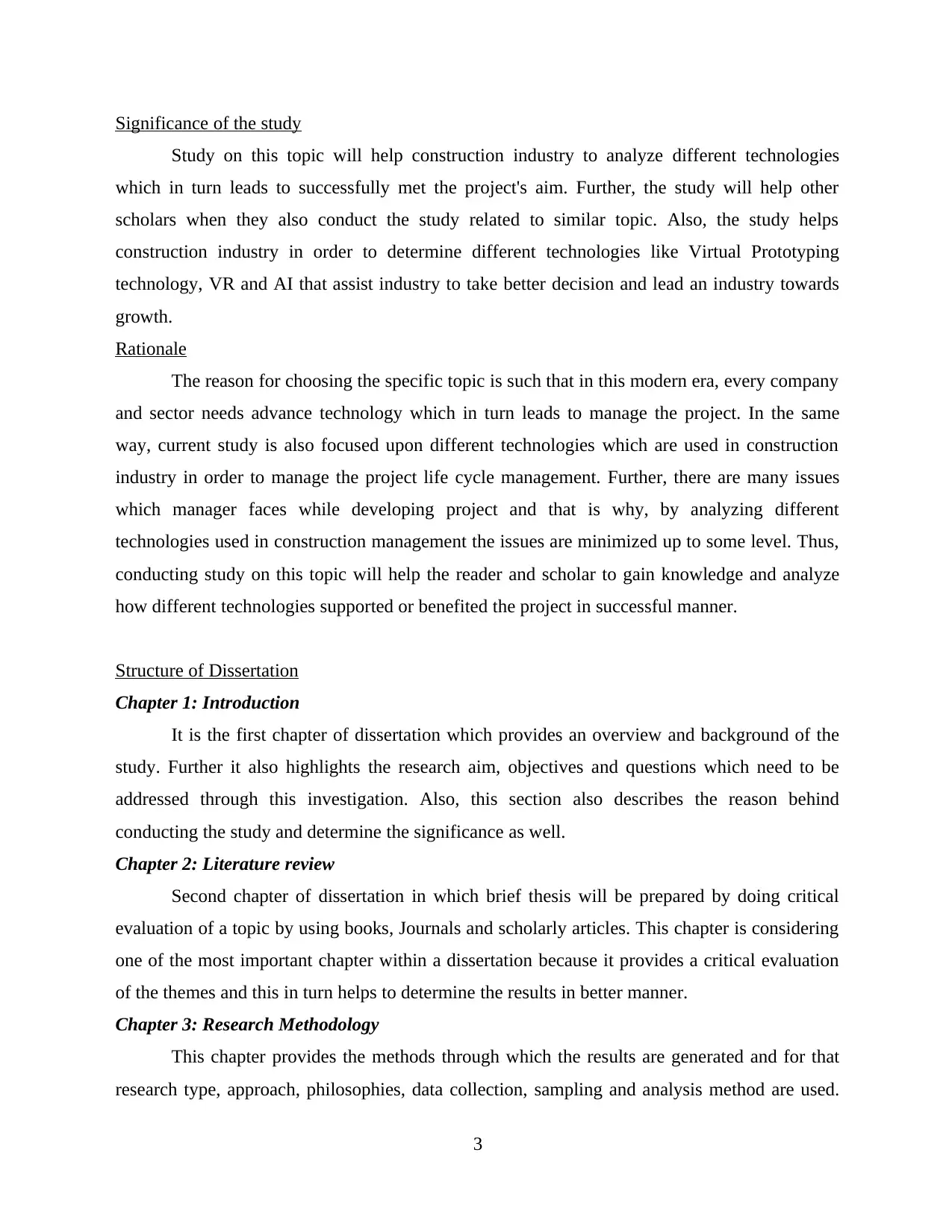
Significance of the study
Study on this topic will help construction industry to analyze different technologies
which in turn leads to successfully met the project's aim. Further, the study will help other
scholars when they also conduct the study related to similar topic. Also, the study helps
construction industry in order to determine different technologies like Virtual Prototyping
technology, VR and AI that assist industry to take better decision and lead an industry towards
growth.
Rationale
The reason for choosing the specific topic is such that in this modern era, every company
and sector needs advance technology which in turn leads to manage the project. In the same
way, current study is also focused upon different technologies which are used in construction
industry in order to manage the project life cycle management. Further, there are many issues
which manager faces while developing project and that is why, by analyzing different
technologies used in construction management the issues are minimized up to some level. Thus,
conducting study on this topic will help the reader and scholar to gain knowledge and analyze
how different technologies supported or benefited the project in successful manner.
Structure of Dissertation
Chapter 1: Introduction
It is the first chapter of dissertation which provides an overview and background of the
study. Further it also highlights the research aim, objectives and questions which need to be
addressed through this investigation. Also, this section also describes the reason behind
conducting the study and determine the significance as well.
Chapter 2: Literature review
Second chapter of dissertation in which brief thesis will be prepared by doing critical
evaluation of a topic by using books, Journals and scholarly articles. This chapter is considering
one of the most important chapter within a dissertation because it provides a critical evaluation
of the themes and this in turn helps to determine the results in better manner.
Chapter 3: Research Methodology
This chapter provides the methods through which the results are generated and for that
research type, approach, philosophies, data collection, sampling and analysis method are used.
3
Study on this topic will help construction industry to analyze different technologies
which in turn leads to successfully met the project's aim. Further, the study will help other
scholars when they also conduct the study related to similar topic. Also, the study helps
construction industry in order to determine different technologies like Virtual Prototyping
technology, VR and AI that assist industry to take better decision and lead an industry towards
growth.
Rationale
The reason for choosing the specific topic is such that in this modern era, every company
and sector needs advance technology which in turn leads to manage the project. In the same
way, current study is also focused upon different technologies which are used in construction
industry in order to manage the project life cycle management. Further, there are many issues
which manager faces while developing project and that is why, by analyzing different
technologies used in construction management the issues are minimized up to some level. Thus,
conducting study on this topic will help the reader and scholar to gain knowledge and analyze
how different technologies supported or benefited the project in successful manner.
Structure of Dissertation
Chapter 1: Introduction
It is the first chapter of dissertation which provides an overview and background of the
study. Further it also highlights the research aim, objectives and questions which need to be
addressed through this investigation. Also, this section also describes the reason behind
conducting the study and determine the significance as well.
Chapter 2: Literature review
Second chapter of dissertation in which brief thesis will be prepared by doing critical
evaluation of a topic by using books, Journals and scholarly articles. This chapter is considering
one of the most important chapter within a dissertation because it provides a critical evaluation
of the themes and this in turn helps to determine the results in better manner.
Chapter 3: Research Methodology
This chapter provides the methods through which the results are generated and for that
research type, approach, philosophies, data collection, sampling and analysis method are used.
3
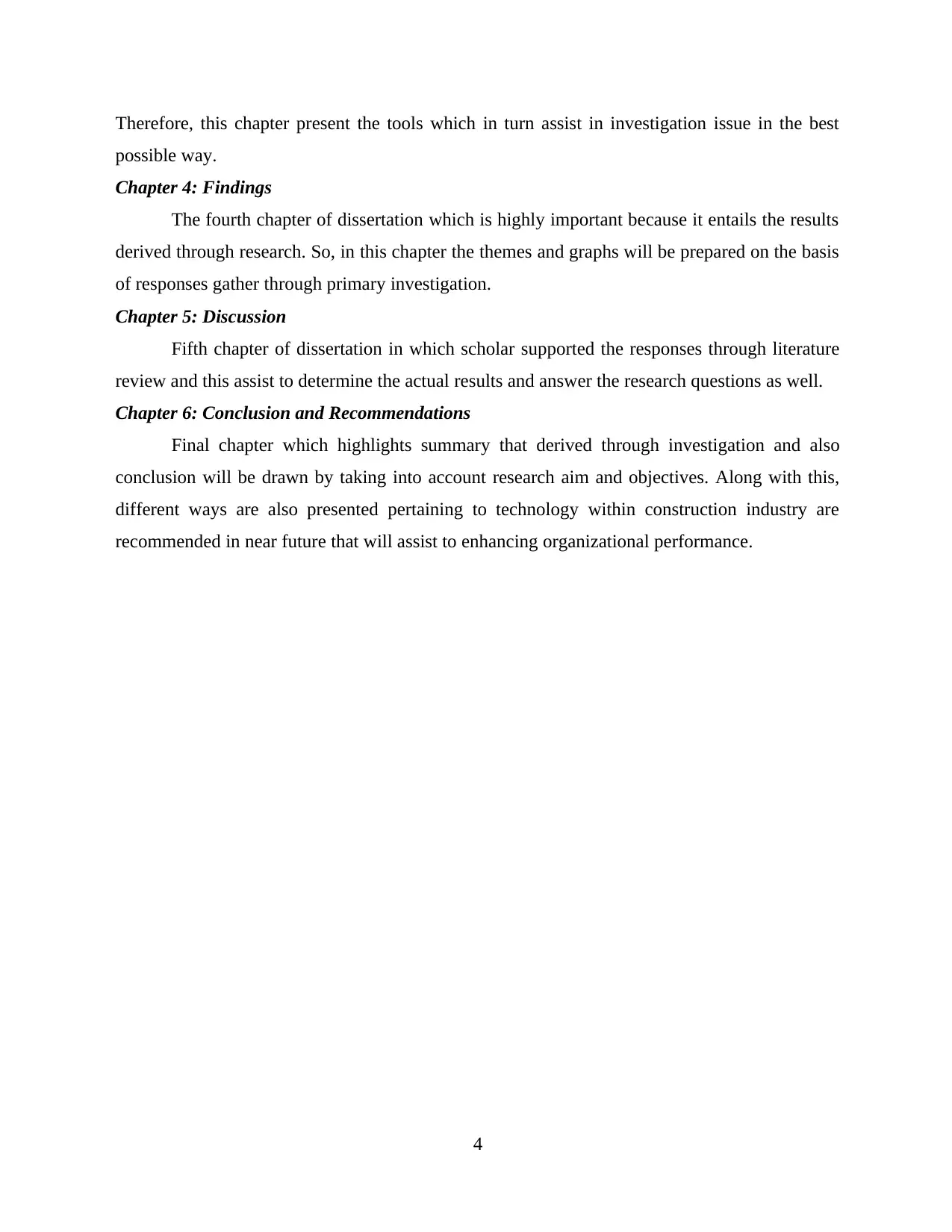
Therefore, this chapter present the tools which in turn assist in investigation issue in the best
possible way.
Chapter 4: Findings
The fourth chapter of dissertation which is highly important because it entails the results
derived through research. So, in this chapter the themes and graphs will be prepared on the basis
of responses gather through primary investigation.
Chapter 5: Discussion
Fifth chapter of dissertation in which scholar supported the responses through literature
review and this assist to determine the actual results and answer the research questions as well.
Chapter 6: Conclusion and Recommendations
Final chapter which highlights summary that derived through investigation and also
conclusion will be drawn by taking into account research aim and objectives. Along with this,
different ways are also presented pertaining to technology within construction industry are
recommended in near future that will assist to enhancing organizational performance.
4
possible way.
Chapter 4: Findings
The fourth chapter of dissertation which is highly important because it entails the results
derived through research. So, in this chapter the themes and graphs will be prepared on the basis
of responses gather through primary investigation.
Chapter 5: Discussion
Fifth chapter of dissertation in which scholar supported the responses through literature
review and this assist to determine the actual results and answer the research questions as well.
Chapter 6: Conclusion and Recommendations
Final chapter which highlights summary that derived through investigation and also
conclusion will be drawn by taking into account research aim and objectives. Along with this,
different ways are also presented pertaining to technology within construction industry are
recommended in near future that will assist to enhancing organizational performance.
4
⊘ This is a preview!⊘
Do you want full access?
Subscribe today to unlock all pages.

Trusted by 1+ million students worldwide
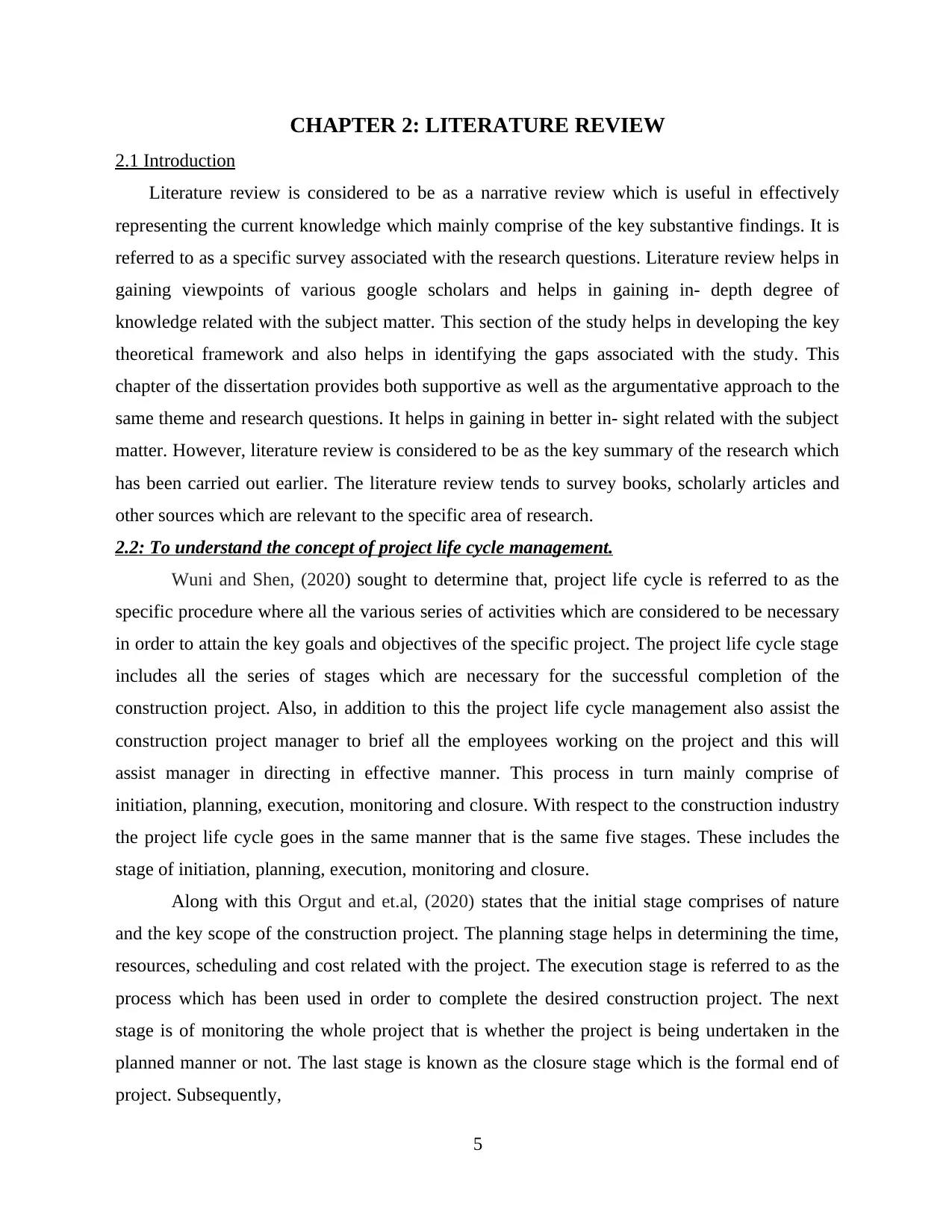
CHAPTER 2: LITERATURE REVIEW
2.1 Introduction
Literature review is considered to be as a narrative review which is useful in effectively
representing the current knowledge which mainly comprise of the key substantive findings. It is
referred to as a specific survey associated with the research questions. Literature review helps in
gaining viewpoints of various google scholars and helps in gaining in- depth degree of
knowledge related with the subject matter. This section of the study helps in developing the key
theoretical framework and also helps in identifying the gaps associated with the study. This
chapter of the dissertation provides both supportive as well as the argumentative approach to the
same theme and research questions. It helps in gaining in better in- sight related with the subject
matter. However, literature review is considered to be as the key summary of the research which
has been carried out earlier. The literature review tends to survey books, scholarly articles and
other sources which are relevant to the specific area of research.
2.2: To understand the concept of project life cycle management.
Wuni and Shen, (2020) sought to determine that, project life cycle is referred to as the
specific procedure where all the various series of activities which are considered to be necessary
in order to attain the key goals and objectives of the specific project. The project life cycle stage
includes all the series of stages which are necessary for the successful completion of the
construction project. Also, in addition to this the project life cycle management also assist the
construction project manager to brief all the employees working on the project and this will
assist manager in directing in effective manner. This process in turn mainly comprise of
initiation, planning, execution, monitoring and closure. With respect to the construction industry
the project life cycle goes in the same manner that is the same five stages. These includes the
stage of initiation, planning, execution, monitoring and closure.
Along with this Orgut and et.al, (2020) states that the initial stage comprises of nature
and the key scope of the construction project. The planning stage helps in determining the time,
resources, scheduling and cost related with the project. The execution stage is referred to as the
process which has been used in order to complete the desired construction project. The next
stage is of monitoring the whole project that is whether the project is being undertaken in the
planned manner or not. The last stage is known as the closure stage which is the formal end of
project. Subsequently,
5
2.1 Introduction
Literature review is considered to be as a narrative review which is useful in effectively
representing the current knowledge which mainly comprise of the key substantive findings. It is
referred to as a specific survey associated with the research questions. Literature review helps in
gaining viewpoints of various google scholars and helps in gaining in- depth degree of
knowledge related with the subject matter. This section of the study helps in developing the key
theoretical framework and also helps in identifying the gaps associated with the study. This
chapter of the dissertation provides both supportive as well as the argumentative approach to the
same theme and research questions. It helps in gaining in better in- sight related with the subject
matter. However, literature review is considered to be as the key summary of the research which
has been carried out earlier. The literature review tends to survey books, scholarly articles and
other sources which are relevant to the specific area of research.
2.2: To understand the concept of project life cycle management.
Wuni and Shen, (2020) sought to determine that, project life cycle is referred to as the
specific procedure where all the various series of activities which are considered to be necessary
in order to attain the key goals and objectives of the specific project. The project life cycle stage
includes all the series of stages which are necessary for the successful completion of the
construction project. Also, in addition to this the project life cycle management also assist the
construction project manager to brief all the employees working on the project and this will
assist manager in directing in effective manner. This process in turn mainly comprise of
initiation, planning, execution, monitoring and closure. With respect to the construction industry
the project life cycle goes in the same manner that is the same five stages. These includes the
stage of initiation, planning, execution, monitoring and closure.
Along with this Orgut and et.al, (2020) states that the initial stage comprises of nature
and the key scope of the construction project. The planning stage helps in determining the time,
resources, scheduling and cost related with the project. The execution stage is referred to as the
process which has been used in order to complete the desired construction project. The next
stage is of monitoring the whole project that is whether the project is being undertaken in the
planned manner or not. The last stage is known as the closure stage which is the formal end of
project. Subsequently,
5
Paraphrase This Document
Need a fresh take? Get an instant paraphrase of this document with our AI Paraphraser
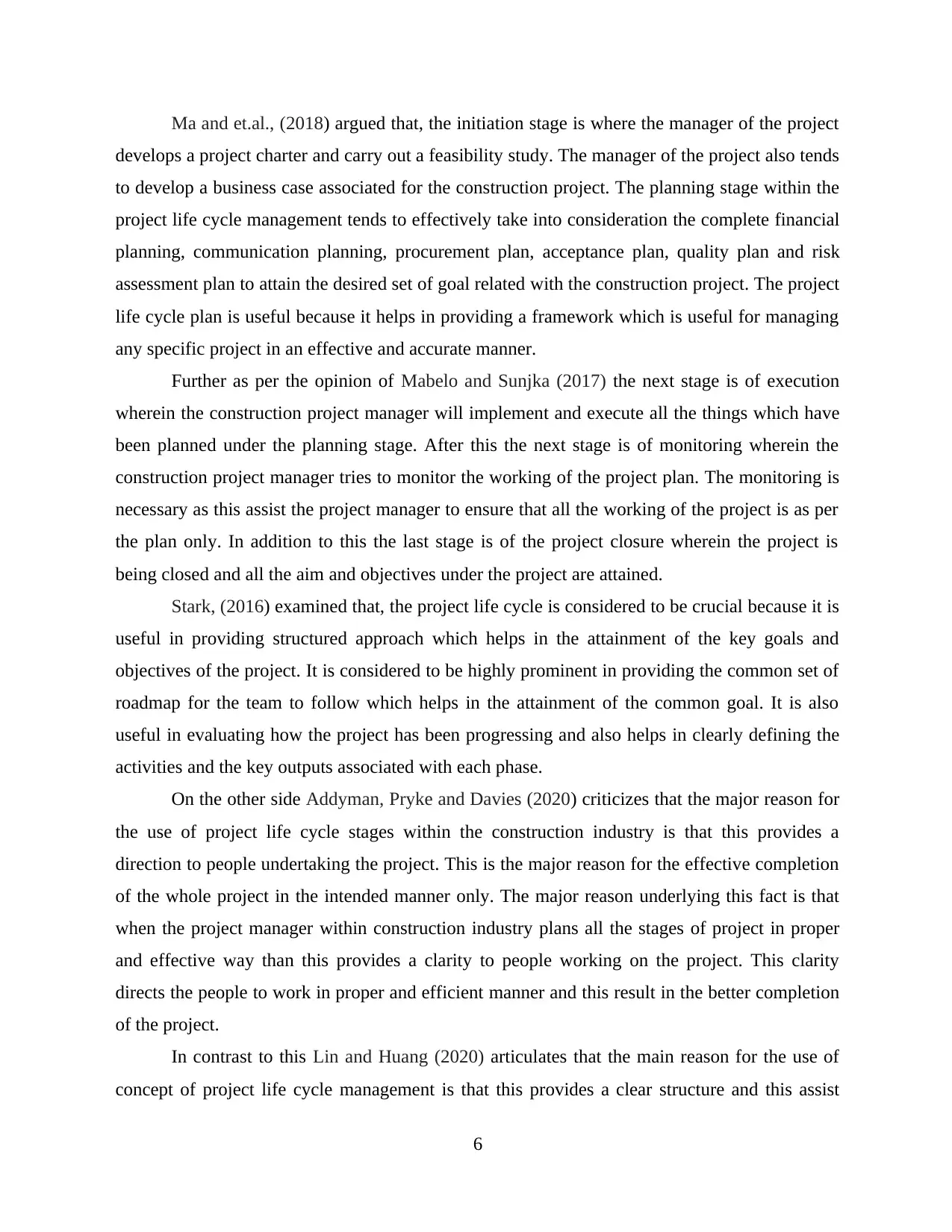
Ma and et.al., (2018) argued that, the initiation stage is where the manager of the project
develops a project charter and carry out a feasibility study. The manager of the project also tends
to develop a business case associated for the construction project. The planning stage within the
project life cycle management tends to effectively take into consideration the complete financial
planning, communication planning, procurement plan, acceptance plan, quality plan and risk
assessment plan to attain the desired set of goal related with the construction project. The project
life cycle plan is useful because it helps in providing a framework which is useful for managing
any specific project in an effective and accurate manner.
Further as per the opinion of Mabelo and Sunjka (2017) the next stage is of execution
wherein the construction project manager will implement and execute all the things which have
been planned under the planning stage. After this the next stage is of monitoring wherein the
construction project manager tries to monitor the working of the project plan. The monitoring is
necessary as this assist the project manager to ensure that all the working of the project is as per
the plan only. In addition to this the last stage is of the project closure wherein the project is
being closed and all the aim and objectives under the project are attained.
Stark, (2016) examined that, the project life cycle is considered to be crucial because it is
useful in providing structured approach which helps in the attainment of the key goals and
objectives of the project. It is considered to be highly prominent in providing the common set of
roadmap for the team to follow which helps in the attainment of the common goal. It is also
useful in evaluating how the project has been progressing and also helps in clearly defining the
activities and the key outputs associated with each phase.
On the other side Addyman, Pryke and Davies (2020) criticizes that the major reason for
the use of project life cycle stages within the construction industry is that this provides a
direction to people undertaking the project. This is the major reason for the effective completion
of the whole project in the intended manner only. The major reason underlying this fact is that
when the project manager within construction industry plans all the stages of project in proper
and effective way than this provides a clarity to people working on the project. This clarity
directs the people to work in proper and efficient manner and this result in the better completion
of the project.
In contrast to this Lin and Huang (2020) articulates that the main reason for the use of
concept of project life cycle management is that this provides a clear structure and this assist
6
develops a project charter and carry out a feasibility study. The manager of the project also tends
to develop a business case associated for the construction project. The planning stage within the
project life cycle management tends to effectively take into consideration the complete financial
planning, communication planning, procurement plan, acceptance plan, quality plan and risk
assessment plan to attain the desired set of goal related with the construction project. The project
life cycle plan is useful because it helps in providing a framework which is useful for managing
any specific project in an effective and accurate manner.
Further as per the opinion of Mabelo and Sunjka (2017) the next stage is of execution
wherein the construction project manager will implement and execute all the things which have
been planned under the planning stage. After this the next stage is of monitoring wherein the
construction project manager tries to monitor the working of the project plan. The monitoring is
necessary as this assist the project manager to ensure that all the working of the project is as per
the plan only. In addition to this the last stage is of the project closure wherein the project is
being closed and all the aim and objectives under the project are attained.
Stark, (2016) examined that, the project life cycle is considered to be crucial because it is
useful in providing structured approach which helps in the attainment of the key goals and
objectives of the project. It is considered to be highly prominent in providing the common set of
roadmap for the team to follow which helps in the attainment of the common goal. It is also
useful in evaluating how the project has been progressing and also helps in clearly defining the
activities and the key outputs associated with each phase.
On the other side Addyman, Pryke and Davies (2020) criticizes that the major reason for
the use of project life cycle stages within the construction industry is that this provides a
direction to people undertaking the project. This is the major reason for the effective completion
of the whole project in the intended manner only. The major reason underlying this fact is that
when the project manager within construction industry plans all the stages of project in proper
and effective way than this provides a clarity to people working on the project. This clarity
directs the people to work in proper and efficient manner and this result in the better completion
of the project.
In contrast to this Lin and Huang (2020) articulates that the main reason for the use of
concept of project life cycle management is that this provides a clear structure and this assist
6
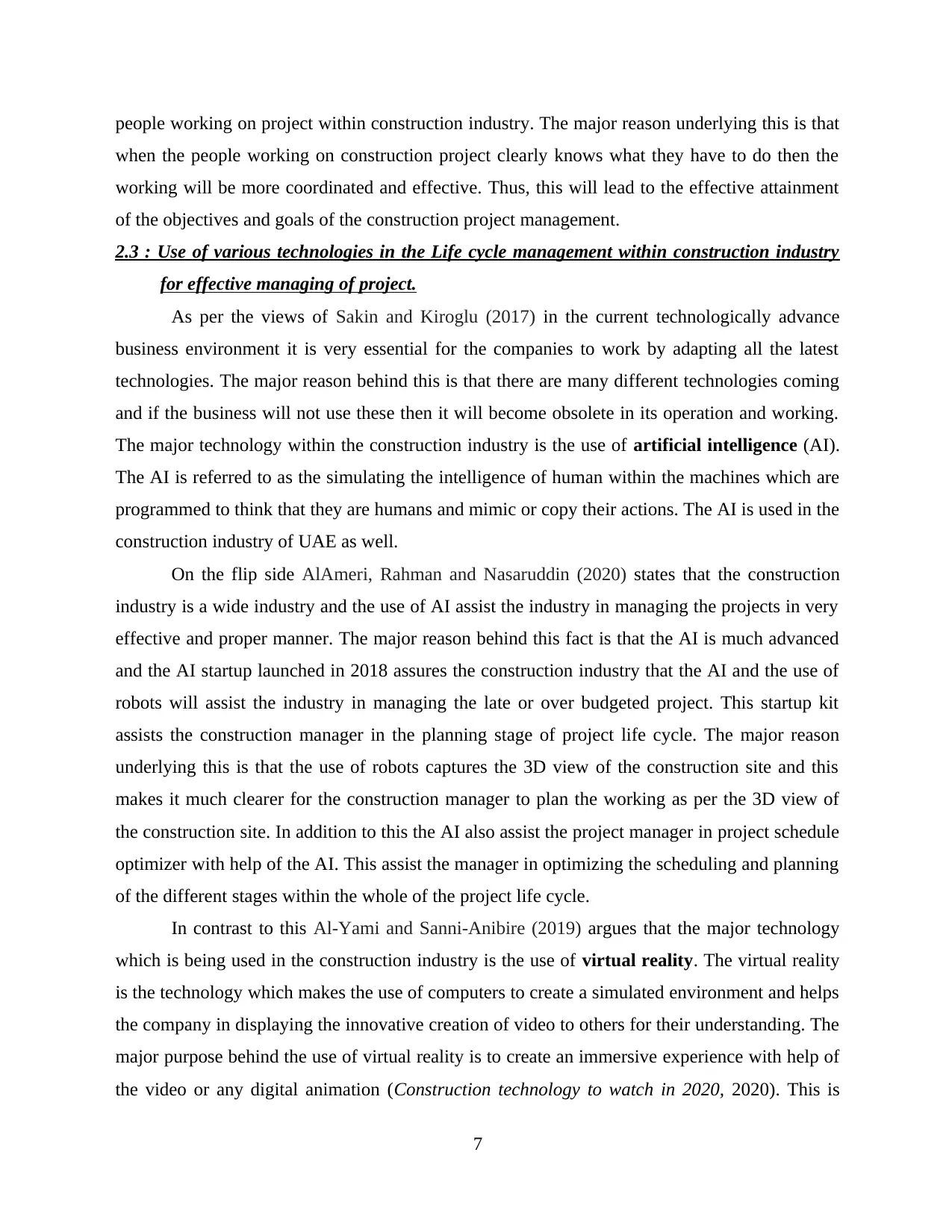
people working on project within construction industry. The major reason underlying this is that
when the people working on construction project clearly knows what they have to do then the
working will be more coordinated and effective. Thus, this will lead to the effective attainment
of the objectives and goals of the construction project management.
2.3 : Use of various technologies in the Life cycle management within construction industry
for effective managing of project.
As per the views of Sakin and Kiroglu (2017) in the current technologically advance
business environment it is very essential for the companies to work by adapting all the latest
technologies. The major reason behind this is that there are many different technologies coming
and if the business will not use these then it will become obsolete in its operation and working.
The major technology within the construction industry is the use of artificial intelligence (AI).
The AI is referred to as the simulating the intelligence of human within the machines which are
programmed to think that they are humans and mimic or copy their actions. The AI is used in the
construction industry of UAE as well.
On the flip side AlAmeri, Rahman and Nasaruddin (2020) states that the construction
industry is a wide industry and the use of AI assist the industry in managing the projects in very
effective and proper manner. The major reason behind this fact is that the AI is much advanced
and the AI startup launched in 2018 assures the construction industry that the AI and the use of
robots will assist the industry in managing the late or over budgeted project. This startup kit
assists the construction manager in the planning stage of project life cycle. The major reason
underlying this is that the use of robots captures the 3D view of the construction site and this
makes it much clearer for the construction manager to plan the working as per the 3D view of
the construction site. In addition to this the AI also assist the project manager in project schedule
optimizer with help of the AI. This assist the manager in optimizing the scheduling and planning
of the different stages within the whole of the project life cycle.
In contrast to this Al-Yami and Sanni-Anibire (2019) argues that the major technology
which is being used in the construction industry is the use of virtual reality. The virtual reality
is the technology which makes the use of computers to create a simulated environment and helps
the company in displaying the innovative creation of video to others for their understanding. The
major purpose behind the use of virtual reality is to create an immersive experience with help of
the video or any digital animation (Construction technology to watch in 2020, 2020). This is
7
when the people working on construction project clearly knows what they have to do then the
working will be more coordinated and effective. Thus, this will lead to the effective attainment
of the objectives and goals of the construction project management.
2.3 : Use of various technologies in the Life cycle management within construction industry
for effective managing of project.
As per the views of Sakin and Kiroglu (2017) in the current technologically advance
business environment it is very essential for the companies to work by adapting all the latest
technologies. The major reason behind this is that there are many different technologies coming
and if the business will not use these then it will become obsolete in its operation and working.
The major technology within the construction industry is the use of artificial intelligence (AI).
The AI is referred to as the simulating the intelligence of human within the machines which are
programmed to think that they are humans and mimic or copy their actions. The AI is used in the
construction industry of UAE as well.
On the flip side AlAmeri, Rahman and Nasaruddin (2020) states that the construction
industry is a wide industry and the use of AI assist the industry in managing the projects in very
effective and proper manner. The major reason behind this fact is that the AI is much advanced
and the AI startup launched in 2018 assures the construction industry that the AI and the use of
robots will assist the industry in managing the late or over budgeted project. This startup kit
assists the construction manager in the planning stage of project life cycle. The major reason
underlying this is that the use of robots captures the 3D view of the construction site and this
makes it much clearer for the construction manager to plan the working as per the 3D view of
the construction site. In addition to this the AI also assist the project manager in project schedule
optimizer with help of the AI. This assist the manager in optimizing the scheduling and planning
of the different stages within the whole of the project life cycle.
In contrast to this Al-Yami and Sanni-Anibire (2019) argues that the major technology
which is being used in the construction industry is the use of virtual reality. The virtual reality
is the technology which makes the use of computers to create a simulated environment and helps
the company in displaying the innovative creation of video to others for their understanding. The
major purpose behind the use of virtual reality is to create an immersive experience with help of
the video or any digital animation (Construction technology to watch in 2020, 2020). This is
7
⊘ This is a preview!⊘
Do you want full access?
Subscribe today to unlock all pages.

Trusted by 1+ million students worldwide
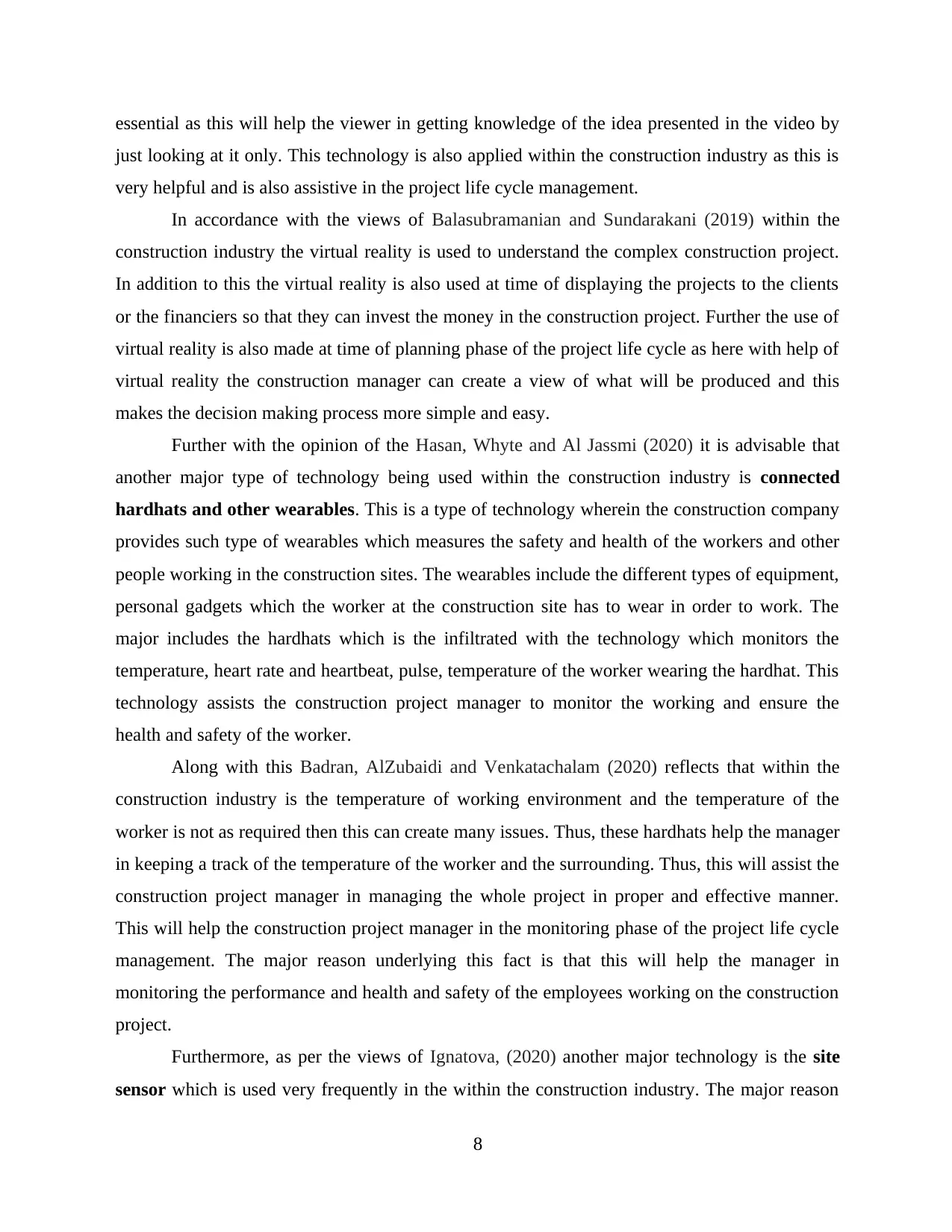
essential as this will help the viewer in getting knowledge of the idea presented in the video by
just looking at it only. This technology is also applied within the construction industry as this is
very helpful and is also assistive in the project life cycle management.
In accordance with the views of Balasubramanian and Sundarakani (2019) within the
construction industry the virtual reality is used to understand the complex construction project.
In addition to this the virtual reality is also used at time of displaying the projects to the clients
or the financiers so that they can invest the money in the construction project. Further the use of
virtual reality is also made at time of planning phase of the project life cycle as here with help of
virtual reality the construction manager can create a view of what will be produced and this
makes the decision making process more simple and easy.
Further with the opinion of the Hasan, Whyte and Al Jassmi (2020) it is advisable that
another major type of technology being used within the construction industry is connected
hardhats and other wearables. This is a type of technology wherein the construction company
provides such type of wearables which measures the safety and health of the workers and other
people working in the construction sites. The wearables include the different types of equipment,
personal gadgets which the worker at the construction site has to wear in order to work. The
major includes the hardhats which is the infiltrated with the technology which monitors the
temperature, heart rate and heartbeat, pulse, temperature of the worker wearing the hardhat. This
technology assists the construction project manager to monitor the working and ensure the
health and safety of the worker.
Along with this Badran, AlZubaidi and Venkatachalam (2020) reflects that within the
construction industry is the temperature of working environment and the temperature of the
worker is not as required then this can create many issues. Thus, these hardhats help the manager
in keeping a track of the temperature of the worker and the surrounding. Thus, this will assist the
construction project manager in managing the whole project in proper and effective manner.
This will help the construction project manager in the monitoring phase of the project life cycle
management. The major reason underlying this fact is that this will help the manager in
monitoring the performance and health and safety of the employees working on the construction
project.
Furthermore, as per the views of Ignatova, (2020) another major technology is the site
sensor which is used very frequently in the within the construction industry. The major reason
8
just looking at it only. This technology is also applied within the construction industry as this is
very helpful and is also assistive in the project life cycle management.
In accordance with the views of Balasubramanian and Sundarakani (2019) within the
construction industry the virtual reality is used to understand the complex construction project.
In addition to this the virtual reality is also used at time of displaying the projects to the clients
or the financiers so that they can invest the money in the construction project. Further the use of
virtual reality is also made at time of planning phase of the project life cycle as here with help of
virtual reality the construction manager can create a view of what will be produced and this
makes the decision making process more simple and easy.
Further with the opinion of the Hasan, Whyte and Al Jassmi (2020) it is advisable that
another major type of technology being used within the construction industry is connected
hardhats and other wearables. This is a type of technology wherein the construction company
provides such type of wearables which measures the safety and health of the workers and other
people working in the construction sites. The wearables include the different types of equipment,
personal gadgets which the worker at the construction site has to wear in order to work. The
major includes the hardhats which is the infiltrated with the technology which monitors the
temperature, heart rate and heartbeat, pulse, temperature of the worker wearing the hardhat. This
technology assists the construction project manager to monitor the working and ensure the
health and safety of the worker.
Along with this Badran, AlZubaidi and Venkatachalam (2020) reflects that within the
construction industry is the temperature of working environment and the temperature of the
worker is not as required then this can create many issues. Thus, these hardhats help the manager
in keeping a track of the temperature of the worker and the surrounding. Thus, this will assist the
construction project manager in managing the whole project in proper and effective manner.
This will help the construction project manager in the monitoring phase of the project life cycle
management. The major reason underlying this fact is that this will help the manager in
monitoring the performance and health and safety of the employees working on the construction
project.
Furthermore, as per the views of Ignatova, (2020) another major technology is the site
sensor which is used very frequently in the within the construction industry. The major reason
8
Paraphrase This Document
Need a fresh take? Get an instant paraphrase of this document with our AI Paraphraser
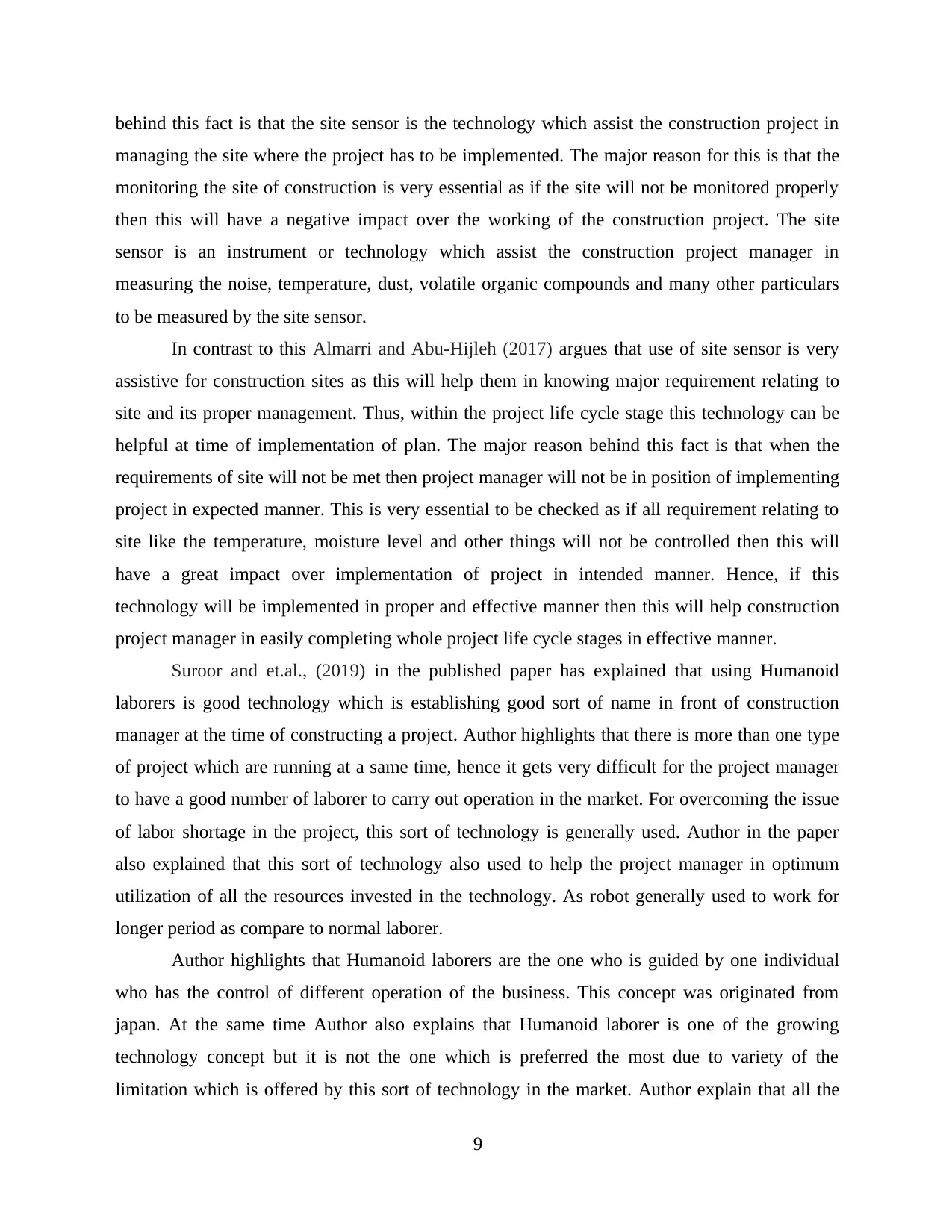
behind this fact is that the site sensor is the technology which assist the construction project in
managing the site where the project has to be implemented. The major reason for this is that the
monitoring the site of construction is very essential as if the site will not be monitored properly
then this will have a negative impact over the working of the construction project. The site
sensor is an instrument or technology which assist the construction project manager in
measuring the noise, temperature, dust, volatile organic compounds and many other particulars
to be measured by the site sensor.
In contrast to this Almarri and Abu-Hijleh (2017) argues that use of site sensor is very
assistive for construction sites as this will help them in knowing major requirement relating to
site and its proper management. Thus, within the project life cycle stage this technology can be
helpful at time of implementation of plan. The major reason behind this fact is that when the
requirements of site will not be met then project manager will not be in position of implementing
project in expected manner. This is very essential to be checked as if all requirement relating to
site like the temperature, moisture level and other things will not be controlled then this will
have a great impact over implementation of project in intended manner. Hence, if this
technology will be implemented in proper and effective manner then this will help construction
project manager in easily completing whole project life cycle stages in effective manner.
Suroor and et.al., (2019) in the published paper has explained that using Humanoid
laborers is good technology which is establishing good sort of name in front of construction
manager at the time of constructing a project. Author highlights that there is more than one type
of project which are running at a same time, hence it gets very difficult for the project manager
to have a good number of laborer to carry out operation in the market. For overcoming the issue
of labor shortage in the project, this sort of technology is generally used. Author in the paper
also explained that this sort of technology also used to help the project manager in optimum
utilization of all the resources invested in the technology. As robot generally used to work for
longer period as compare to normal laborer.
Author highlights that Humanoid laborers are the one who is guided by one individual
who has the control of different operation of the business. This concept was originated from
japan. At the same time Author also explains that Humanoid laborer is one of the growing
technology concept but it is not the one which is preferred the most due to variety of the
limitation which is offered by this sort of technology in the market. Author explain that all the
9
managing the site where the project has to be implemented. The major reason for this is that the
monitoring the site of construction is very essential as if the site will not be monitored properly
then this will have a negative impact over the working of the construction project. The site
sensor is an instrument or technology which assist the construction project manager in
measuring the noise, temperature, dust, volatile organic compounds and many other particulars
to be measured by the site sensor.
In contrast to this Almarri and Abu-Hijleh (2017) argues that use of site sensor is very
assistive for construction sites as this will help them in knowing major requirement relating to
site and its proper management. Thus, within the project life cycle stage this technology can be
helpful at time of implementation of plan. The major reason behind this fact is that when the
requirements of site will not be met then project manager will not be in position of implementing
project in expected manner. This is very essential to be checked as if all requirement relating to
site like the temperature, moisture level and other things will not be controlled then this will
have a great impact over implementation of project in intended manner. Hence, if this
technology will be implemented in proper and effective manner then this will help construction
project manager in easily completing whole project life cycle stages in effective manner.
Suroor and et.al., (2019) in the published paper has explained that using Humanoid
laborers is good technology which is establishing good sort of name in front of construction
manager at the time of constructing a project. Author highlights that there is more than one type
of project which are running at a same time, hence it gets very difficult for the project manager
to have a good number of laborer to carry out operation in the market. For overcoming the issue
of labor shortage in the project, this sort of technology is generally used. Author in the paper
also explained that this sort of technology also used to help the project manager in optimum
utilization of all the resources invested in the technology. As robot generally used to work for
longer period as compare to normal laborer.
Author highlights that Humanoid laborers are the one who is guided by one individual
who has the control of different operation of the business. This concept was originated from
japan. At the same time Author also explains that Humanoid laborer is one of the growing
technology concept but it is not the one which is preferred the most due to variety of the
limitation which is offered by this sort of technology in the market. Author explain that all the
9
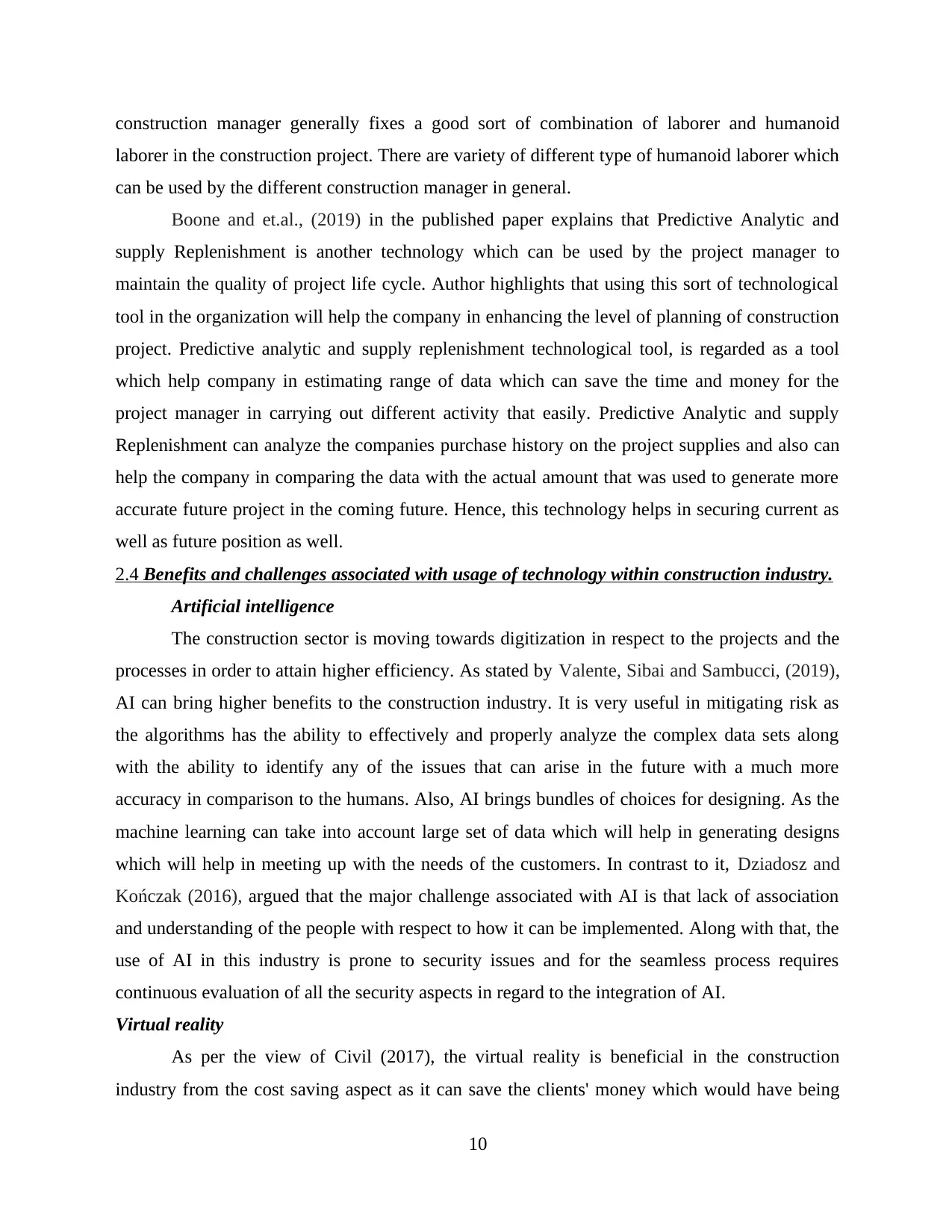
construction manager generally fixes a good sort of combination of laborer and humanoid
laborer in the construction project. There are variety of different type of humanoid laborer which
can be used by the different construction manager in general.
Boone and et.al., (2019) in the published paper explains that Predictive Analytic and
supply Replenishment is another technology which can be used by the project manager to
maintain the quality of project life cycle. Author highlights that using this sort of technological
tool in the organization will help the company in enhancing the level of planning of construction
project. Predictive analytic and supply replenishment technological tool, is regarded as a tool
which help company in estimating range of data which can save the time and money for the
project manager in carrying out different activity that easily. Predictive Analytic and supply
Replenishment can analyze the companies purchase history on the project supplies and also can
help the company in comparing the data with the actual amount that was used to generate more
accurate future project in the coming future. Hence, this technology helps in securing current as
well as future position as well.
2.4 Benefits and challenges associated with usage of technology within construction industry.
Artificial intelligence
The construction sector is moving towards digitization in respect to the projects and the
processes in order to attain higher efficiency. As stated by Valente, Sibai and Sambucci, (2019),
AI can bring higher benefits to the construction industry. It is very useful in mitigating risk as
the algorithms has the ability to effectively and properly analyze the complex data sets along
with the ability to identify any of the issues that can arise in the future with a much more
accuracy in comparison to the humans. Also, AI brings bundles of choices for designing. As the
machine learning can take into account large set of data which will help in generating designs
which will help in meeting up with the needs of the customers. In contrast to it, Dziadosz and
Kończak (2016), argued that the major challenge associated with AI is that lack of association
and understanding of the people with respect to how it can be implemented. Along with that, the
use of AI in this industry is prone to security issues and for the seamless process requires
continuous evaluation of all the security aspects in regard to the integration of AI.
Virtual reality
As per the view of Civil (2017), the virtual reality is beneficial in the construction
industry from the cost saving aspect as it can save the clients' money which would have being
10
laborer in the construction project. There are variety of different type of humanoid laborer which
can be used by the different construction manager in general.
Boone and et.al., (2019) in the published paper explains that Predictive Analytic and
supply Replenishment is another technology which can be used by the project manager to
maintain the quality of project life cycle. Author highlights that using this sort of technological
tool in the organization will help the company in enhancing the level of planning of construction
project. Predictive analytic and supply replenishment technological tool, is regarded as a tool
which help company in estimating range of data which can save the time and money for the
project manager in carrying out different activity that easily. Predictive Analytic and supply
Replenishment can analyze the companies purchase history on the project supplies and also can
help the company in comparing the data with the actual amount that was used to generate more
accurate future project in the coming future. Hence, this technology helps in securing current as
well as future position as well.
2.4 Benefits and challenges associated with usage of technology within construction industry.
Artificial intelligence
The construction sector is moving towards digitization in respect to the projects and the
processes in order to attain higher efficiency. As stated by Valente, Sibai and Sambucci, (2019),
AI can bring higher benefits to the construction industry. It is very useful in mitigating risk as
the algorithms has the ability to effectively and properly analyze the complex data sets along
with the ability to identify any of the issues that can arise in the future with a much more
accuracy in comparison to the humans. Also, AI brings bundles of choices for designing. As the
machine learning can take into account large set of data which will help in generating designs
which will help in meeting up with the needs of the customers. In contrast to it, Dziadosz and
Kończak (2016), argued that the major challenge associated with AI is that lack of association
and understanding of the people with respect to how it can be implemented. Along with that, the
use of AI in this industry is prone to security issues and for the seamless process requires
continuous evaluation of all the security aspects in regard to the integration of AI.
Virtual reality
As per the view of Civil (2017), the virtual reality is beneficial in the construction
industry from the cost saving aspect as it can save the clients' money which would have being
10
⊘ This is a preview!⊘
Do you want full access?
Subscribe today to unlock all pages.

Trusted by 1+ million students worldwide
1 out of 23
Related Documents
Your All-in-One AI-Powered Toolkit for Academic Success.
+13062052269
info@desklib.com
Available 24*7 on WhatsApp / Email
![[object Object]](/_next/static/media/star-bottom.7253800d.svg)
Unlock your academic potential
Copyright © 2020–2025 A2Z Services. All Rights Reserved. Developed and managed by ZUCOL.





